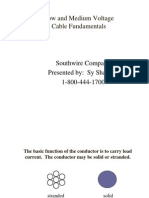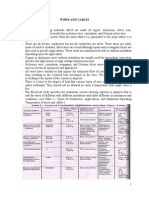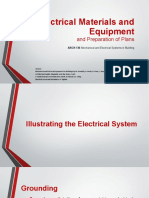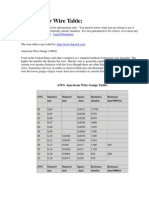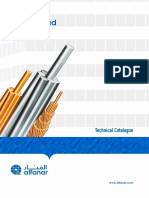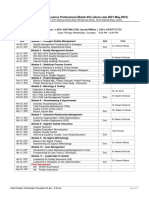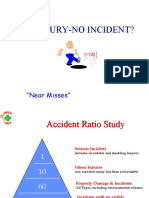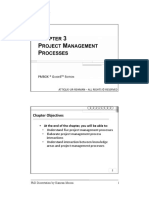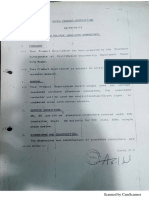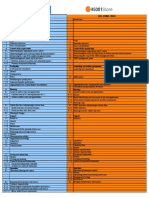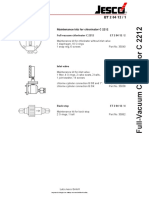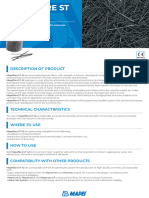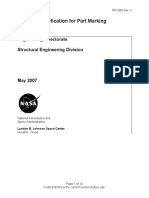Custom Design
Conductors
Available options
The central component of any cable: the conductor is
the term used for the metallic wire or wires that carry the signal To improve durability and flexibility it is common to strand multiple
and/or power through the cable. wires together, the more wires that are stranded together to
make a given size, the more flexible the conductor will be.
Metals
A wide range of metals can be used as a conductor. Copper Sizes
(Cu) is by far the most common due to its relative low cost and There are many different national and international standards
availability. Other options include aluminium, steel or tinsel wire for identifying the size of a conductor and terminology such as
(mixed strands of copper and cotton). While these may offer BWG, SWG and Cmils; however American Wire Gauge (AWG)
advantages in weight, strength or flex-life, they almost always and Metric (mm2) conductors are pretty much standard today. It
come at the cost of reduced conductivity. is quite common to use both of these methods as they indicate
subtly different sizes - see Habia Cable’s AWG vs. Metric
Plated copper such as Tin Plated Copper (TPC), Silver Plated conversion table for details.
Copper (SPC) and Nickel Plated Copper (NPC) offer additional
benefits like improved temperature resistance, conductivity One note regarding AWG sizes is that the higher the number, the
or solderability. Purer conductors such as Oxygen Free High smaller the wire. For example: AWG 2 (8.64mm) is bigger than
Conductivity (OFHC) copper can improve the signal performance AWG 20 at just 0,96mm.
and are often used for audio frequencies, whilst High Strength
Copper Alloy (HSA) can improve flex-life compared to standard Other factors
copper conductors. Some other issues that influence the choice of conductor
include, but are not lmited to:
A variety of other alloys are often used for their unique conducting • Crimp terminations: Use as few strands as possible and avoid
properties when exposed to heat. Known as resistance wires, rope-lay or bunched conductors.
they are used in thermocouple cables where they can detect
variations in temperature. The most commonly used are Nickel- • Soldered terminations: Use TPC or SPC for best results and
Chromium (NiCr), Copper-Nickel (CuNi) and Iron (Fe). avoid NPC.
• Data/signal: Use solid, smooth-surfaced conductors and
Strandings SPC or steel for best results.
The simplest conductor is a single, solid strand. Although this • Dynamic: Use as many strands as possible and high
offers the smallest diameter, the purest signal and the largest strength copper alloy for best results.
Cross-Sectional Area (CSA), this is also mechanically weak,
• High temperature: Use SPC (+200oC) or NPC (+260oC) for
solid conductors are prone to breaking after just a few cycles of best results.
bending. Conductors are categorised into classes based on the
number of strands. The higher the class, the more strands in the
Weight and conductor resistance
conductor:
Some values such as weight, resistance and CSA may vary slightly
• Class 1: Solid, round. between different platings and different wire specifications.
• Class 2: Stranded conductor, (typically 7 or 19 strands).
• Class 5: Multi-stranded for general, flexible use. Some small sizes (normally AWG 32 to AWG36) are recommended
with High Strength Copper Alloy (HSA) conductors only as their
• Class 6: Extra-multi-stranded for dynamic use. size is too small to process safely with weaker materials.
12 12 www.habia.com
�Custom Design
Conductors
AWG vs. Metric conversion (1 of 2)
Size Stranding Diameter Resistance Weight
CSA Ω/km at 20oC Nom
AWG Min Nom Max
mm2 TPC g/m
- 400 2,013 x 0.500 28.00 30.00 31.00 0.0495 3,588
- 300 1,525 x 0.500 24.00 26.00 27.00 0.0654 2,718
- 240 1,221 x 0.500 22.00 23.00 24.00 0.0817 2,176
- 185 925 x 0.500 19.00 20.00 21.00 0.108 1,649
- 150 777 x 0.500 17.00 18.00 19.00 0.132 1,385
- 120 629 x 0.500 15.00 16.00 17.00 0.164 1,121
0000 107 2,109 x 0.254 - 15.20 - 0.189 1,018
- 95.0 475 x 0.500 13.50 14.30 15.10 0.210 847
000 - 646 x 0.410 - 13.70 - 0.250 760
- 70.0 361 x 0.500 11.70 12.40 13.10 0.277 643
00 68.0 1,330 x 0.260 11.18 11.80 12.07 0.290 654
0 53.0 1,045 x 0.260 10.03 10.50 10.80 0.370 504
- 50.0 399 x 0.404 9.600 10.30 11.00 0.393 455
- 35.0 278 x 0.404 7.800 8.400 9.200 0.565 319
2 34.0 665 x 0.260 8.130 8.400 8.640 0.580 318
- 25.0 196 x 0.404 6.600 7.200 7.800 0.795 224
4 21.6 133 x 0.455 - 6.600 - 0.920 192
- 16.0 126 x 0.404 5.300 5.700 6.100 1.24 144
6 13.6 133 x 0.361 - 5,200 - 1.37 128
- 10.0 80 x 0.404 3.850 3.930 4.070 1.85 91.0
8 8.60 133 x 0.287 - 4.100 - 2.29 77.7
- 6.00 84 x 0.300 2.840 2.920 3.040 3.20 53.0
10 4.74 37 x 0.404 - 2.850 - 4.13 43.5
- 4.00 56 x 0.300 2.390 2.480 2.530 4.80 36.0
3.09 19 x 0.455 2.083 2.150 2.184 6.29 27.67
12
3.00 37 x 0.320 2.020 2.100 2.180 7.60 23.30
- 2.50 50 x 0.254 1.870 1.950 2.010 7.80 21.90
2.00 37 x 0.250 1.680 1.750 1.820 10.90 16.69
14
1.94 19 x 0.361 1.651 1.706 1.753 10.00 17.41
1.50 30 x 0.254 1.430 1.500 1.570 13.00 13.60
-
1.50 19 x 0.320 1.470 1.520 1.570 13.00 13.60
1.23 19 x 0.287 1.321 1.358 1.397 15.81 11.00
16
1.30 1 x 1.290 1.278 1.290 1.328 13.99 11.63
- 1.00 32 x 0.203 1.150 1.200 1.290 19.00 9.000
0.963 19 x 0.254 1.169 1.201 1.245 20.40 8.634
18 0.897 7 x 0.404 1.194 1.212 1.270 21.45 8.049
0.823 1 x 1.024 1.013 1.024 1.054 22.23 7.330
0.750 24 x 0.203 1.030 1.050 1.080 25.00 6,800
-
0.750 19 x 0.226 1.030 1.080 1.150 25.00 6.800
19 0.650 1 x 0.900 0.855 0.900 0.909 28.50 5.662
0.615 19 x 0.203 0.940 0.961 0.991 32.02 5.512
20 0.563 7 x 0.320 0.915 0.960 0.991 34.12 5.046
0.519 1 x 0.813 0.805 0.813 0.838 35.21 4.620
0.500 19 x 0.180 0.860 0.880 0.900 38.00 4.300
-
0.500 16 x 0.203 0.820 0.880 0.920 38.00 4.500
0.382 19 x 0.160 0.737 0.757 0.787 52.16 3.433
0.354 7 x 0.254 0.712 0.762 0.788 54.79 3.188
0.324 1 x 0.643 0.635 0.643 0.663 56.62 2.890
23 0.283 1 x 0.600 0.570 0.600 0.606 64.00 2.516
Continued on page 2 of 2
www.habia.com 13 13
� Custom Design
Conductors
AWG vs. Metric conversion (2 of 2)
Size Stranding Diameter Resistance Weight
CSA Ω/km at 20oC Nom
AWG Min Nom Max
mm2 TPC g/m
0.241 19 x 0.127 0.584 0.600 0.610 83.33 2.159
24 0.220 7 x 0.203 0.585 0.609 0.635 85.95 2.033
0.205 1 x 0.511 0.515 0.511 0.526 89.35 1.825
0.155 19 x 0.102 0.457 0.480 0.508 131.5 1.392
26 0.140 7 x 0.160 0.458 0.480 0.508 139.7 1.263
0.128 1 x 0.404 0.399 0.404 0.417 146.6 1.141
0.095 19 x 0.079 0.355 0.372 0.394 222.1 0.835
28 0.089 7 x 0.127 0.356 0.381 0.406 223.7 0.793
0.080 1 x 0.320 0.318 0.320 0.330 231.3 0.716
0.061 19 x 0.060 - - - 320.9 -
30 0.057 7 x 0.102 0.280 0.306 0.330 354.3 0.511
0.050 1 x 0.254 0.251 0.254 0.262 372.7 0.451
0.037 19 x 0.052 - 427.3 -
32 0.035 7 x 0.079 0.224 0.237 0.279 597.1 0.307
0.032 1 x 0.203 0.201 0.203 0.211 585.3 0.288
0.023 7 x 0.060 - 871.1 -
34
0.020 1 x 0.160 0.157 0.160 0.168 950.2 0.179
0.014 7 x 0.050 - 1,160 -
36
0.013 1 x 0.127 0.124 0.127 0.135 1,521 0.113
Weight and conductor resistance values may vary Twisting the cores
slightly for the different platings that can be offered. Sizes 32 increases the conductor resistance with values around 5%
AWG to 36 AWG use High Strength Copper Alloy (HSA) as their higher than a straight, insulated conductor. Different platings
size is too small to process safely with weaker materials. change conductor resistance (e.g. AWG 3007):
• TPC = 355 Ω/km
As with cross-sectional area, further small differences can be
• SPC = 328 Ω/km
found between different international and national specifications.
• NPC = 348 Ω/km
The resistance of a stranded conductor is around 3% higher • HSA = 373 Ω/km
than their equivalent solid conductor size.
14 14 www.habia.com

